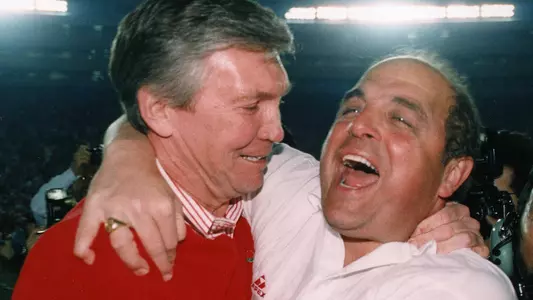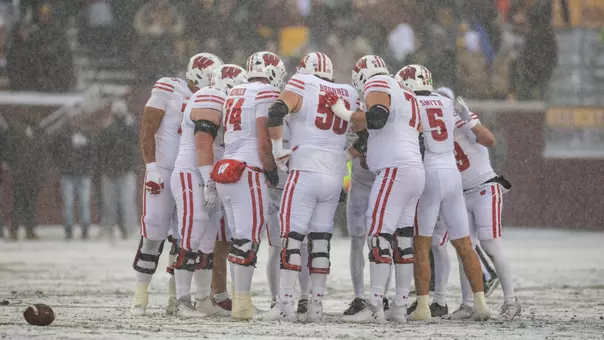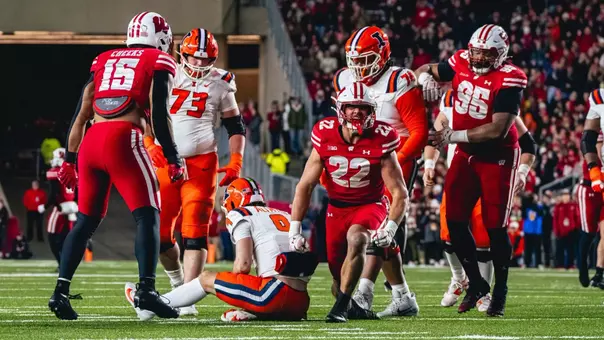
1999-2000: An Unrivaled Year for Wisconsin
September 27, 2019 | Football, General News, Andy Baggot
Looking back at the Badgers’ dream season
 |
||
|
BY ANDY BAGGOT
UWBadgers.com Insider
MADISON, Wis. — Jim Delany had just taken over as Big Ten Conference commissioner in 1989 when he began assessing the merits of each member school. All had their issues to some degree, but one in particular bothered him.
"I was new on the scene," he said, "but didn't need a lot of experience to sort of recognize the troubled waters at Wisconsin with regards to facilities, optimism, confidence."
Delany saw that the marquee football program in Madison was in the midst of five consecutive losing seasons and average attendance at Camp Randall Stadium had plummeted from a school-record 74,681 to 41,734 in six years.
He saw that the marquee men's basketball team had one winning record in the previous 10 seasons, played before modest four-figure crowds at the antiquated Field House and hadn't been to the NCAA tournament since 1947.
Delany saw that the marquee men's hockey squad was on its way to winning a fifth NCAA championship in 1990, but its success as a perennial powerhouse at the off-campus Dane County Coliseum wasn't nearly enough to offset an athletic department budget deficit that would surge past $2 million by 1991.
He saw that the flow of red ink was so volatile that Wisconsin officials elected to drop five sports — baseball, men's and women's fencing and men's and women's gymnastics — in 1991 an attempt to rein in expenditures.
It all added up to a mystery for Delany, who saw a first-class academic institution with a one-of-a-kind campus tucked in a picturesque state capitol and wondered why Wisconsin largely struggled to cultivate success from its front-line sports programs.
"Wow, why aren't they better?" he wondered. "They have a lot of the ingredients."

Still, Delany, fresh off a 10-year stint as commissioner of the Ohio Valley Conference, sensed promise amid all the controversy and gloom in Madison.
He liked Donna Shalala, who was hired as Wisconsin chancellor in 1988 and subsequently served on the search committee that tabbed Delany to run the Big Ten.
Shalala proceeded to clean house in the athletic department, dismissing AD Ade Sponberg and football coach Don Morton and convincing Pat Richter, a local businessman and Badgers icon, to leave his corporate digs to be the athletic director.

Richter, a Madison native and three-sport standout at Wisconsin, proceeded to hire Notre Dame defensive coordinator Barry Alvarez as football coach.
In a span of 12 months, the culture, perception and fortunes of Wisconsin Athletics began to change in a series of profound ways.
"While things didn't happen immediately, there was a certain energy and leadership emanating from Donna and Pat and Barry," Delany recalled. "There was reason to think there might be a success here, but there hadn't been any proof."
It would come to life gradually, but not before Richter embarked on a fascinating project. He summoned Bob Drane, a former executive colleague at Oscar Mayer, and asked him to stage a strategic planning session for his senior staff.
Drane told the group to think 10 years out and compile a list of things they'd like to have accomplished as an athletic department. The wish list was scrawled in black ink on an enlarged sheet of white paper mounted on an easel.
- National reputation for academic and athletic success
- Budget completely self-supporting
- New facilities for basketball, hockey and administration
- Three bowl games, including one Rose Bowl
- NCAA Final Four appearance in men's basketball
- Full scholarships for all sports
Not every item germinated — the idea of upgrading facilities for baseball and gymnastics was abandoned — but the success rate in hindsight is astounding.
"That was our wish list back in 1990," Richter said. "There's a trail there."

It took four years for Alvarez to create a Big Ten championship team — built on toughness and a blue-collar attitude — push home attendance up to 75,507 and win the first of three Rose Bowls during his coaching tenure.
It took five years for that multi-million-dollar budget deficit to be replaced by a reserve balance of $2.5 million.
It took six years for a series of new sports to appear on the Wisconsin manifest — all for women — putting the overall number at 23. Lightweight rowing (1995) and hockey (1999) have since won multiple national championships, while softball (1996) has won a Big Ten tournament title and become an NCAA tournament fixture.
It took eight years for the first modern stand-alone athletic facility of the Shalala-Richter-Alvarez Era to be built on campus. Private donations totaling $37.5 million, coupled with proceeds from a premium seating plan, sparked the creation of the $76.4-million Kohl Center, where men's and women's basketball and men's hockey began playing their home games in 1998.

It took 10 years for the rebuild to fully blossom. The 1999-2000 school year was unlike any in Wisconsin athletic history, before or since, in terms of high-profile achievements and national impact in a wide variety of sports.
The 20th anniversary of that magical time is upon us. Remember?
Five future University of Wisconsin Hall of Fame coaches were in residence: Alvarez, Dick Bennett in men's basketball, Ed Nuttycombe in men's track, Jeff Sauer in men's hockey and Peter Tegen in women's track and cross country.
The football team won its second consecutive Big Ten football championship — becoming just the fourth school in the modern era to claim back-to-back titles — and surfaced as the first league team to win successive Rose Bowls in the modern era.
Tailback Ron Dayne, whose senior season concluded with the NCAA career record for rushing yards and the coveted Heisman Trophy, was the focal point of that squad.
The men's basketball team advanced to the NCAA Final Four for the first time since winning the national crown in 1941.
The men's cross country team won every race it entered before placing second in the NCAA meet, its best finish since being the runner-up in 1992.
The men's hockey team was ranked No. 1 in the nation during its run to winning the MacNaughton Cup as Western Collegiate Hockey Association regular-season champions.
The women's basketball team — featuring three career 1,000-point scorers — won the National Invitational Tournament, while league titles were won in four other sports: men's and women's cross country and men's indoor and outdoor track.
Erica Palmer won the NCAA women's cross country crown, while Donny Pritzlaff secured the NCAA wrestling title at 165 pounds.
Dayne, Steve Reinprecht (men's hockey) and Michael Bennett (men's indoor track) were named conference athletes of the year by their respective sports.
Palmer, Pritzlaff, Matt Downin (men's cross country), Ellen Stonebraker and Gina Panighetti (women's swimming) recorded Big Ten individual crowns.
Dayne and offensive tackle Chris McIntosh were first-round NFL draft selections, while winger Dany Heatley was the second overall pick in the NHL draft.
All the resulting financial success set the stage for a $109.5 million renovation of Camp Randall, which began in 2001. By the time it was completed four years later, capacity was at 80,321 thanks to the addition of suites and indoor seating and a gleaming administrative office complex was up and running.
Twenty years later, Richter, who retired as AD in 2004, recalled the strategic planning exercise and all those prescient entries with a quiet sense of satisfaction.
"We put all those things on the board," he said. "Most of them we achieved, maybe at a higher level than we had thought.
"But when we got there and those things had happened, nobody thought, 'Boy, we've arrived.' We saw this as just another step toward long-term success."
The most elaborate celebration of the feats was a photo collage that appeared on a billboard attached to the Field House.
"We were hungry for more," Richter said. "We accepted 2000 as being an outstanding year and that things were coming together."

The Badgers have won six Big Ten football titles overall since 1993, including three straight in 2010, '11 and '12. Men's basketball, meanwhile, has appeared in 19 of the last 20 NCAA tournaments and recently compiled a 17-year streak of finishing in the top four of the Big Ten.
Delany is best known for introducing the Big Ten Network, overseeing three episodes of expansion to 14 members and negotiating lucrative media rights contracts for all the institutions.
Big Ten schools responded by winning 151 NCAA championships on Delany's watch through 2018-19, 11 courtesy of the Badgers: five in women's hockey (2006, '07, '09, '11, '19), two in men's hockey (1990 and 2006) and men's cross country (2005 and '11), and one each in men's soccer (1995) and men's indoor track (2007).
Delany takes great pride in all the Big Ten schools and their stories, but said there's something special about the "unrivaled" way Wisconsin officials found their athletic bearings.
"From my perspective, I do not know if there's another Division I program at one of the major conferences that came from where they came from and then sustained it," he said. "Truly remarkable. I was here and watched it."
Delany's tenure with the Big Ten nearly mirrors that of Alvarez, who became Wisconsin Director of Athletics in April of 2004 and doubled as football coach through the 2005 season.
Alvarez is currently the most-tenured AD in the Big Ten and is eighth overall among the 130 Football Bowl Subdivision schools.
"He was a good collaborator," Delany said of Alvarez. "It was obvious that his building of Wisconsin and success at the Rose Bowl and the way he collaborated with the other coaches in the conference were all really positive signs.
"There's not been an athletic director with a football background who's been more capable."
Delany said the road map Wisconsin followed from the poor house to national prominence — emphasizing continuity, fit, steadiness and patience — has been utilized by other schools over the years. He mentioned Northwestern and its resurgent football and men's basketball programs as a prime example.
"I think he's always been pretty proud of that," Alvarez said of Delany.
He's not alone.
"I'm very proud of that because it's hard to do," Alvarez said. "We don't have the wherewithal that a lot of schools have in our league."
But it's Wisconsin that owns the longest active bowl streak among Big Ten teams at 17 and it's the Badgers who have won five straight bowl assignments, the longest streak of its kind in the league.
"For us to establish ourselves over a long period of time — to have the success that we've had and coming from where we were without a tradition — was very hard to do and is very gratifying," Alvarez said.
"We're right there with everybody. We have a chance to win national championships. There's no one we can't compete with."
The foundation of Wisconsin's athletic stability is built on football. Since 2004, the program has amassed 149 football victories, which ranks fifth among Power 5 programs behind Alabama, Ohio State, Oklahoma and Clemson.
"It all goes back to filling this place," Alvarez said, gesturing toward Camp Randall. "Then you can build facilities. Then you can have budgets other than football and men's basketball, where they have the wherewithal to compete. It all ties together, but it starts with football."
Richter, whose No. 88 is one of six retired uniform numbers at Camp Randall, said serving as athletic director at his alma mater has brought him almost daily rewards.
That list he and his staff compiled in 1990 also included state of the art tech tools, an annual giveback of $1 million to the campus scholarship fund and a positive relationship with Bascom Hill. All those things have been realized, too.
"To this day, whether I'm in a grocery store or a game or the airport or just out in public, people will come up and shake your hand and say 'Thank you,'" he said. "That means more than anything."













